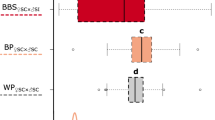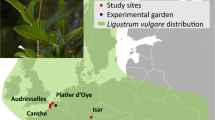Summary
A brief survey is given of the genetics of self-compatibilith in species with a one-locus gametophytic system of incompatibility.
A study has been made of the genetics of the self-compatibility found in L. peruvianum.
From the results of various test crosses and selfings and of cytological research it is concluded that self-compatibility in L. peruvianum can be based on different types of S-allele mutations, on addition of an S-allele bearing chromosome fragment, or on genes modifying the S-allele expressivity.
The results further indicate that generation of new S-alleles is a frequently occurring phenomenon in inbred material of L. peruvianum and that pollen with an S-allele mutation or an extra chromosome fragment is less vital than normal pollen.
A short notation for incompatibility genotypes is given.
Similar content being viewed by others
References
Ascher, P. D., 1966. A gene action model to explain gametophytic self-incompatibility. Euphytica 15: 179–183.
Atwood, S. S., 1942. Genetics of pseudo-self-compatibility and its relation to cross-incompatibility in Trifolium repens. J. agric. Res. 64: 699–709.
Atwood, S. S., 1945. The behaviour of the self-compatibility factor and its relation to breeding methods in Trifolium repens. J. Am. Soc. Agron. 37: 991–1004.
Atwood, S. S. & Brewbaker, J. L., 1950. Multiple oppositional alleles in autoploid white clover. Genetics 35: 653.
Atwood, S. S. & Brewbaker, J. L., 1953. Incompatibility in autoploid white clover. Cornell Univ. agric. Exp. St Mem. 319: 1–47.
Bianchi, F. & Dijkhuizen, L., 1961. Zelf-incompatibiliteit bij Petunia. Genen Phaenen 6: 1–14.
Brewbaker, J. L., 1953. Oppositional allelism in diploid and autotetraploid Trifolium hybridum L. Genetics 38: 444–455.
Brewbaker, J. L., 1954. Incompatibility in autotetraploid Trifolium repens L. I. Competition and self-incompatibility. Genetics 39: 307–316.
Brewbaker, J. L. & Natarajan, A. T., 1960. Centric fragments and pollen-part mutation of incompatibility alleles in Petunia. Genetics 45: 699–704.
Denward, T., 1963. The function of the incompatibility alleles in red clover (Trifolium pratense L.) Hereditas 49: 189–236, 285–334.
East, E. M., 1932. Studies on self-sterility. IX. The behaviour of crosses between self-sterile and self-fertile plants. Genetics 17: 175–202.
Günther, E., Herrmann, H. & Hoffmann, M., 1968. Untersuchungen zur Selbstinkompatibilität von Lycopersicon peruvianum (L.) Mill. Biol. Zbl. 87: 471–479.
Hoffmann, M., 1971. Induktion und Analyse von selbstkompatiblen Mutanten bei Lycopersicon peruvianum (L.) Mill. II. Analyse der selbstkompatiblen Mutanten. Biol. Zbl. 90: 33–41.
Hogenboom, N. G., 1968. Self-compatibility in Lycopersicum peruvianum (L.) Mill. Euphytica 17: 220–223.
Hogenboom, N. G., 1972. Breaking breeding barriers in Lycopersicon. 2. Breakdown of self-incompatibility in L. peruvianum (L.) Mill. Euphytica 21: 228–243.
Lamm, R., 1950. Self-incompatibility in Lycopersicon peruvianum Mill. Herditas 36: 509–510.
Leffel, R. C., 1963. Pseudo-self-compatibility and segregation of gametophytic self-incompatibility alleles in red clover, Trifolium pratense L. Crop Sci. 3: 377–380.
Lewis, D., 1943. Physiology of incompatibility in plants. III. Autopolyploids. J. Genet. 45: 171–185.
Lewis, D., 1947a. Splitting the gene. Discovery 8: 168–173.
Lewis, D., 1947b. Competition and dominance of incompatibility alleles in diploid pollen. Heredity 1: 85–108.
Lewis, D., 1949. Structure of the incompatibility gene. II. Induced mutation rate. Heredity 3: 339–355.
Lewis, D., 1951. Structure of the incompatibility gene. III. Types of spontaneous and induced mutation. Heredity 5: 399–414.
Lewis, D., 1958. Gene control of specificity and activity: loss by mutation and restoration by complementation. Nature 182: 1620–1621.
Lewis, D., 1960. Genetic control of specificity and activity of the S antigen in plants. Proc. R. Soc. Lond. ser. B 151: 468–477.
Lewis, D., 1961. Chromosome fragments and mutation of the incompatibility gene. Nature 190: 990–991.
Lewis, D., 1965. A protein dimer hypothesis on incompatibility. Genet. Today, 3: 657–663.
Lewis, D. & Crowe, L. K., 1953. Theory of revertible mutations. Nature 171: 501.
Lewis, D. & Crowe, L. K., 1954. Structure of the incompatibility gene. IV. Types of mutations in Prunus avium L. Heredity 8: 357–363.
Linskens, H. F., 1968. Egg-sperm interactions in higher plants. Accad. nazn. Linc. Quad. N. 104: 47–56.
Linskens, H. F. & Kroh, M., 1967. Inkompatibilität der Phanerogamen. Handb. PflPhysiol. 18: 506–530.
Lundqvist, A., 1965. The genetics of incompatibility. Genet. Today 3: 637–647.
Lundqvist, A., 1968. The mode of origin of self-fertility in grasses. Hereditas 59: 413–426.
Mather, K., 1943. Specific differences in Petunia. I. Incompatibility. J. Genet. 45: 215–235.
McGuire, D. C. & Rick, C. M., 1954. Self-incompatibility in species of Lycopersicon sect. Eriopersicon and hybrids with L. esculentum. Hilgardia 23: 101–124.
Mosig, G., 1960. Zur Genetik von Petunia hybrida. I. Die Selbststerilität. Z. Vererblehre 91: 158–163.
Nettancourt, D., de & Ecochard, R., 1969. New incompatibility specificities in the M3 progeny of a clonal population of L. peruvianum. Tomato Genet. Coop. Rep. 19: 16–17.
Nettancourt, D., de, Ecochard, R., Perquin, M. D. G., Drift, T., van der & Westerhof, M., 1971. The generation of new S alleles at the incompatibility locus of Lycopersicum peruvianum Mill. Theor. appl. Genet. 41: 120–129.
Pandey, K. K., 1956a. Mutations of self-incompatibility alleles in Trifolium pratense and T. repens. Genetics 41: 327–343.
Pandey, K. K., 1956b. Incompatibility in autotetraploid Trifolium pratense. Genetics 41: 353–366.
Pandey, K. K., 1959. Mutations of the self-incompatibility gene (S) and pseudo-compatibility in angiosperms. Lloydia 22: 222–234.
Pandey, K. K., 1960. Incompatibility in Abutilon ‘hybridum’. Am. J. Bot. 47: 877–883.
Pandey, K. K., 1962. Interactions of S alleles in diploid pollen. Nature 195: 205–206.
Pandey, K. K., 1965. Centric chromosome fragments and pollen-part mutation of the incompatibility gene in Nicotiana alata. Nature 206: 792–795.
Pandey, K. K., 1967a. Origin of genetic variability: Combinations of peroxidase isozymes determine multiple allelism of the S-gene. Nature 213: 669–672.
Pandey, K. K., 1967b. Elements of the S-gene complex. II. Mutation and complementation at the SI locus in Nicotiana alata. Heredity 22: 255–283.
Pandey, K. K., 1968. Colchicine-induced changes in the self-incompatibility behaviour of Nicotiana. Genetica 39: 257–271.
Pandey, K. K., 1969. Elements of the S-gene complex. III. Chromosome fragments and naturally occurring S-gene mutations in Nicotiana bonariensis. Heredity 24: 353–360.
Pandey, K. K., 1970a. Elements of the S-gene complex. VI. Mutations of the self-incompatibility gene, pseudo-compatibility and origin of new self-incompatibility alleles. Genetica 41: 477–516.
Pandey, K. K., 1970b. New self-incompatibility alleles produced through inbreeding. Nature 227: 689–690.
Townsend, C. E., 1965. Self-compatibility studies with tetraploid alsike clover, Trifolium hybridum L. Crop Sci. 5: 295–299.
Townsend, C. E., 1966. Self-compatibility studies with diploid alsike clover, Trifolium hybridum L. II. Inheritance of a self-compatibility factor with gametophytic and sporophytic characteristics. Crop Sci. 6: 415–419.
Townsend, C. E., 1969. Self-compatibility studies with diploid alsike clover, Trifolium hybridum L. IV. Inheritance of type II self-compatibility in different genetic backgrounds. Crop Sci. 9: 443–446.
Wricke, G., 1969. Untersuchungen zur Vererbung der Selbstfertilität beim Roggen (Secale cereale). Theor. appl. Genet. 39: 371–378.
Zeilinga, A. E., 1956. An improved acetic orcein squash method for serial cytological preparations. Euphytica 5: 171–174.
Author information
Authors and Affiliations
Rights and permissions
About this article
Cite this article
Hogenboom, N.G. Breaking breeding barriers in Lycopersicon. 3. Inheritance of self-compatibility in L. peruvianum (L.) Mill. . Euphytica 21, 244–256 (1972). https://doi.org/10.1007/BF00036764
Received:
Issue Date:
DOI: https://doi.org/10.1007/BF00036764




